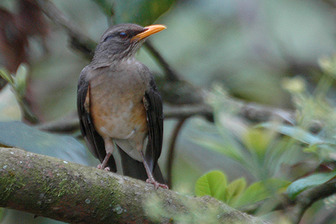African Thrush
African Thrushes are omnivorous, eating a wide range of insects, earthworms and berries. They nest in bushes or similar. They do not form flocks.

Original source: Tom TarrantPermission(Reusing this file)Attribution ShareAlike 3.0
Author: Tom TarrantPermission(Reusing this file)Attribution ShareAlike 3.0
The African Thrush is classified as Least Concern. Does not qualify for a more at risk category. Widespread and abundant taxa are included in this category.
The African Thrush Turdus pelios is a highly variable and taxonomically contentious species found right across central Africa, with perhaps future splits in the offing. Nigerian birds are extremely plain: Clement and Hathaway (in Thrushes Helm, 2000) recognise six races, and the one in central Nigeria would appear to be saturatus. The sexes are similar, and - as the photos below show - juveniles/immatures are typically ’spotted’ and have a dull-coloured bill. More
English: African Thrush, West African Thrush Spanish: Zorzal Africano Finnish: Afrikanlaulurastas French: Grive de Pelios, Grive grisâtre, Merle africain Italian: Tordo africano Japanese: kiashioriabutsugumi Japanese: キアシオリアブツグミ Latin: Turdus libonyanus pelios, Turdus olivaceus pelios, Turdus pelios, Turdus pelios pelios, Turdus stormsi Dutch: Afrikaanse Lijster, Pedioslijster, Pelioslijster Norwegian: Landsbytrost Polish: drozd zóltodzioby, drozd żółtodzioby Slovak: drozd spevavý Swahili: Mkesha wa Afrika Avibase has More
The African Thrush (Turdus pelios) is a passerine bird in the thrush family Turdidae. It is common in well-wooded areas over much of sub-Saharan Africa. Populations are resident. African Thrushes are omnivorous, eating a wide range of insects, earthworms and berries. They nest in bushes or similar. They do not form flocks. Sexes of this large thrush are similar with soft brown upperparts, brown underparts and a yellow bill. More
Other common names: West African Thrush (W races); Cameroon Mountain Thrush (nigrilorum); Fernando Po Thrush (poensis) Taxonomy: Turdus pelios Bonaparte, 1850, Fazughli, Sudan. Taxonomy complex and not fully understood. Has been thought to form a superspecies with T. tephronotus and T. libonyanus. Races chinguancoides, nigrilorum, poensis and centralis have in the past been treated as races of T. olivaceus, and the first two along with saturatus have sometimes been placed with T. libonyanus; bocagei, graueri and stormsi have also been placed with T. olivaceus. More
Product Details Description of Four New African Thrushes of the Genera Plaesticus and Geocichla by E. A. Mearns (Paperback - Jan. 1, 1913)1 used from $5. More
English: African thrush, West African thrush; French: Grive olivâtre; German: Kapdrossel; Spanish: Zorzal olivo. PHYSICAL CHARACTERISTICS 8.3–9.4 in (21–24 cm); 1.9–2.9 oz (54–81 g). Dull olive-brown upperparts and tail, with orange underparts and white vent. Throat is speckled white. Bill and legs are yellow-orange. DISTRIBUTION Africa, from Eritrea and Ethiopia discontinuously south to the Cape, west to Angola. HABITAT Upland and lowland forest, gardens, and hotel grounds. More
African ThrushAfrican Thrush (Turdus pelios) = Thrushes The African Thrush (Turdus pelios) It is common in well-wooded areas over much of sub-Saharan Africa. Populations are resident. African Thrushes are omnivorous, eating a wide range of insects, earthworms and berries. They nest in bushes or similar. They do not form flocks. More
similar to the more common Olive Thrush but the African Thrush is paler and its bill is a yellowish colour. More
vues blogglb — 30 mars 2008 — African Thrush in the Senegambia grounds blogglb — 30 mars 2008 — African Thrush in the Senegambia groundsCatégorie : Animaux Tags :Bird Wildlife Gambia Thrush Chargement… J'aime Enregistrer dans Partager E-mail Skyrock Facebook Twitter MySpace Live Spaces Blogger orkut Buzz reddit Digg Chargement… Connectez-vous ou inscrivez-vous dès maintenant ! Publier un commentaire Répondre Chargement… Résultats pour : Chargement… File d'attente (0) More
